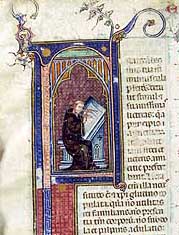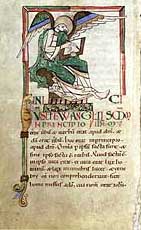Capitular and Archbishopric Archives
- Archives of the Archbishopric of Zagreb
- Capitular archives of Zagreb
- Archives of the Chapter of Čazma
- Archives of Prebendar’s assembly of Zagreb
The Archbishopric of Zagreb signed a contract in 1914 with the Royal Croatian-Slavonian-Dalmatian Government concerning the storage of archives of the Metropolitan capitular of Zagreb into the Royal terrestrial archives. The contract was being renewed every thirty years. Finally in 1996 the contract, valid today, was signed and by this signature the Archbishopric of Zagreb has given in deposit to the Croatian state archives its archives (archives of The Archbishopric of Zagreb 1134-1945; Capitulary archives of Zagreb 1181-1945; archives of capitular of Čazma 1232-1945 and archives of Prebendar’s assembly of Zagreb 1777-1945) and its library material (Metropolitan library). Within the Croatian State Archives these mentioned materials are, in fact, a separate section - the deposit of the Archbishopric of Zagreb. Apart from the materials previously mentioned, inside the premises on Kaptol 27, there are the archives of the auxiliary Spiritual table in Požega, the archives of the Diocesan museum, whom the valuable collection of construction plans belongs to, the archives of various Catholic associations and inheritances of single individuals.
Archives of the Archbishopric of Zagreb
The Archiepiscopal archive was developed through the activity of the Archbishopric of Zagreb from her establishment in 1094 till today. This material is a valuable source for research of church administration, the position of the Archbishopric of Zagreb within the Church, its historical boundaries, political role of the archbishop, rural economy administration of bishop's properties and cultural – scientific activities of individual bishops.
The most significant systematizing of Archives was taken for Bishop M. Vrhovac (1787 – 1827). It was M.J. Kovačić and his son who splitted the Archives into the serials of 10 subjects: privileges, testaments, tithes, records of rural economy, judicial records, ecclesiastically –political records, records of the church administration, the foundational documents and documents of the expropriation. The Kovačićs had also arranged the correspondence of the Zagrebian bishops (1611 – 1815), which continuation is formed by presidential records, that Bishop A. Alagović (1829 – 1837) started creating. The important segment of the archbishopric archives are archidiaconal reports about religious, economical, political and moral circumstances in individual parishes from 1615 till our days (published in: The canon visitations of the Archbishopric of Zagreb 1615 – 1913. Review, Zagreb: Croatian archive, 1989.) The archival group Spiritual table, which was not systematized by the Kovačićs, encloses records of administrating the Archbishopric from 1748 till today. In collection of various protocols the most valuable are the codices of privileges of the bishopric of Zagreb and the monastery of Mother of God in Topusko from the middle of the 14th century, the protocols of in vicar's own hand written oaths, five volumes of Eugen Kvaternik's journal and etc.
Capitular archives of Zagreb
The Zagreb Chapter (Kaptol), established when the Bishopric of Zagreb was founded, as the coresponsible carrier of the administration of the bishopric alongside with the bishop, it has developed during the centuries an extensive activity in ecclestiastical, public, rural economical and other areas. As an institution it belongs in order of the oldest and most important on our ground. The Statutes of Zagreb Chapter (Kaptol) from 1334, as well as Historia Salonitana by Thomas Spalatensis Archdeacon the most significant historical work in Croatia, both testify of its extended activity in 14th century.
The Zagreb Chapter (Kaptol) had vast estates, so the records related to its' administration were important for econimical history. It also arranged a bank of its own kind, emerged mainly, from his members' inheritances, they are, so called, Devouted foundations. Namely, the members of the Zagreb Chapter (Kaptol) were testamently leaving to the Zagreb Chapter (Kaptol), their principals and interrests that were meant for schooling of youth, building churches, helping the poor…etc. In time, these foundation have gained a huge reputation, so the Parliament also entrusted the management of the state money to the Zagreb Chapter (Kaptol)
From 13th century the Zagreb Chapter (Kaptol) had a role
of a credible place (locus credibilis) in political life. The first known
such record comes from the year 1229.
In front of the Zagreb Chapter (Kaptol) sale contracts were being signed
and other property-rights relations were being sorted out: the noblemen
were entered upon the possession of property, Kaptol was taking care of
judicial investiogations, etc. and of those matters, the Zagreb Chapter
(Kaptol) was issuing the transcripts of records with public trust.
Archives of the Cathedral contains records about
all of the mantioned activities, that were kept for centuries in Cathedral's
sacristy next to the most precious things of the treasury.
The content of Archives is divided into the public and the private one.
The public archives relates to the activity of Chapter (Kaptol) as a credible
place, and the private one contains Old records of the Chapter (Kaptol)
till 1700., Records of the Chapter(Kaptol) from 18th century, the Conclave
records 1800 -1918., the Judicial records, Records of various squire's
estate, Records of the cathedral, Deans' testaments and etc.
Archives of the Chapter of Čazma
The Chapter of Čazma was founded in 1232. by the Zagrebian bishop Stjepan II. As a difference to the Zagreb Chapter (Kaptol) which was established next to the cathedral, the Chapter of Čazma was instituted only as an Assembly Chapter, and till the Turkish conquest of Čazma, in the middle of the 16th century, the Zagrebian bishops had their residence there. Then, the deans of Čazma moved to Zagreb, where they became assistants of Zagrebian deans, and their arcihive was moved to Zelina where it stayed till the year 1601. The deans of Čazma did not return to their primary residence, not even, after the liberation of Čazma, instead they gained in replacement a paulist monastery and a property Lepoglava, and in 1811. houses in Varaždin. That's how the Chapter of Čazma –Varaždin emerged, whose name come from more recent period. Like the Chapter of Zagreb, the Chapter of Čazma also performed the service of a credible place, and exactly this archival entirety is the best preserved
Archives of Prebendar’s assembly of Zagreb
The Prebendary's assembly of Zagrebian cathedral consists
of priests who are helping the zagrebian deans in performance of liturgy
in zagrebian cathedral. It is established by the bishop Timotej (1264
– 1287). In 1466. the prebendary's assembly, with a permission from the
Chapter (Kaptol), formed its statutes, which testify of the assembly itself
and the relations within it, and the ecclestiastical service of prebendarys.
In the middle of the 16th century the service of zagrebian prebendarys
is taken over by the banished deans of Čazma. Bishop M. Vrhovac approved
new statutes to the prebendarys in 1800. The assembly's administrative
doing bussiness was known only from 1784, from when the parliament's transcripts
were kept up. The archives of prebendary' assembly are very scanty. The
old part of archive is estranged and partially kept in archives of CASA
(Croatian Academy of Science and Art.
The Metropolitan Library
The beginnings of Metropolitan library are reaching into
the 11th century, to the time when Zagreb is becomnig a bishop town (1093/1094).
In the time of the first zagrebian bishop Duh, the first liturgy books
were also obtained.
Some manuscripts from that period of time such as Evangeliarium,
Sacramentarium sanctae Margaretae, Agenda pontificalis
are kept in Metropolitan library today.
|
|
||||
| Biblia
soliemnis Gothic script, 14th century, France CSA, Metropolitana library |
Evangeliarium Caroline, 11th century CSA, Metropolitana library |
||||
This little group of liturgy codexes is a foundation of today's Library. The oldest inventory of the Zagrebian cathedral's treasury from 1349. testifies about the Metropolitan as a library , there are 111 registered manuscripts in an index of books, and 2 in an indeks of other liturgy subjects inside the trasury. Acording to the inventory, the grounds of the library were juridical, biblical, liturgical, filosophical and theological books. From codexes it's worth to mention the Biblia sollemnis, Liber sententiarum, Passionale and Benedictionale. During the time, Ivan Alben (1421 – 1433) perform function as a bishop a new inventory was made , the last one that brings such an indeks of books. Therefore it's very hard to keep track of the condition in Library during over the next 250 years.
The Metropolitan library reaches the true renesance in the time of bishop
A. I. Mikulić (1688 – 1694), who builded the Library in 1692. and had
all the books from the cathedral transfered in it. He established a foundation
for it's work and bought of a very valuable book collection of known slovenian
polyhistor J.W. Valvasor (1641 – 1693).
S. Želiščević, an inheritor of A. J. Mikulić, published the first Constitutions
of the library in 1695., but great credits are due to two more bishops
for the advancement of the Metropolitan library. M. Vrhovac (1787 – 1827)
provided literature for Metropolitan library from different european states,
he listed books, enlarged the foundation for the functioning of the library,
and especially, took care of books being printed in Zagreb.
In 1846. bishop J. Haulik opened the Library to the zagrebian cultural
public, and he, himself, left a large number of books to the Library.
In the year 1914. a contract between the Archbishopric of Zagreb, Metropolitan
Chapter House (Kaptol) and Nacional and University Library was concluded
about temporarly storage of Metropolitan library in new building of Nacional
and University Library. The owner of the Metropolitan library continues
to be the Archbisopric of Zagreb. The contract about storaging with, today's
owner of the building, CSA, was concluded in 1996.
The Metropolitan library keeps books from, almost, every area of science
and culture. It possesses about 150 older manuscripts (11th -16th century),
amongst which are many richly illuminted and are world's rarities. Fifty
manuscripts from period of 17th till 19th century are included in rarities
of the Metropolitan library (label MR). This Library also keeps the biggest
collection of incunabulums in Croatia (252). It possesses around 300 «younger
manuscripts» (18th – 19th century), and especially valuable is collection
with nearly 1500 titles from the 16th century which, today, are counted
among rarities. From small but valuable atlas and geographical maps collection,
atlases from Ortelius and Janson stand out.
The Metropolitan library today, has around 60.000 volumes of books. Special
value represents, already mentioned, the Valvasor library, whose books
are from, almost, all scientific areas, mostly decorated with copperplates
of a familiar copperplate engraver M. Merian. During his lifetime J.W.
Valvasor gathered a valuable graphic collection with approximately 7.300
graphics and drawings created in period from 15th till 17th century.
He bought a smaller part as a collection from slovenian painter G. Wubitsch,
and a bigger part he collected on his journeys through Europe. At the
end of his lifetime, he sold the collection, through P. R. Vitezović,
to the Zagrebian bishop A. J. Mikulić.
All the significant graphic artists from 15th till 17th century like A.
Dürer, L. Cranach, M. Schöngauer, G. Penz, families Kilian, Sadeler and
Perelle are represented in the collection. The collection is thematically
diversified – except the religious themes, there are plenty of graphics
and drawings with themes from everyday life. Apart from artistic value,
this collection has a huge culturaly –historical significance as it is
the largest and the most significant collection of old graphics and drawings
in Croatia

